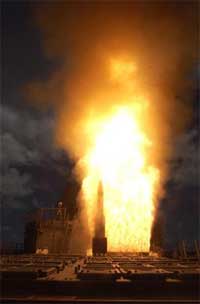 |
| A Standard Missile 3 (SM-3) is launched from the Aegis cruiser USS Shiloh (CG 67), during a joint Missile Defense Agency/U.S. Navy ballistic missile flight test, June 22, 2006. |
WASHINGTON (Reuters) - The United States is set to test key parts of its emerging antimissile shield over the Pacific on Thursday, officially to collect data, but with the possibility that a target dummy warhead will be shot down.
The $85 million exercise is the first involving a live target since interceptor rockets failed to leave their silos during tests in December 2004 and February 2005.
It is also the first since the ground-based system, which is part of a layered shield that includes naval and aerial components, was activated to guard against ballistic missiles test-fired on July 4 and 5 by North Korea.
Boeing Co. is prime contractor for the ground-based mid-course defense, as the backbone is known. Major subcontractors include Lockheed Martin Corp., Northrop Grumman Corp. and Raytheon Co.
In the exercise, a target missile is to be launched from Kodiak, Alaska, between 7 a.m. and noon Pacific time (1400 and 1900 GMT), weather permitting. A backup launch window has been scheduled for Friday.
For the first time, the ground-based interceptor missile is to be launched from Vandenberg Air Force Base in central California. Previous launches have been from the Kwajalein Atoll in the Marshall Islands.
Although an intercept is possible, the main goal is "to collect data on overall system performance and interceptor sensor technology," said Richard Lehner, a spokesman for the Pentagon's Missile Defense Agency.
 In the 10 full-fledged flight intercept tests to date, only five have shot down target missiles. Still, Air Force Lt. Gen. Henry Obering, head of the Missile Defense Agency, has said he is confident the shield would have worked against a U.S.-bound North Korean missile if a decision had been made to shoot it down. In the 10 full-fledged flight intercept tests to date, only five have shot down target missiles. Still, Air Force Lt. Gen. Henry Obering, head of the Missile Defense Agency, has said he is confident the shield would have worked against a U.S.-bound North Korean missile if a decision had been made to shoot it down.
North Korea test-fired seven missiles over the U.S. Independence Day holiday, including for the first time a long-range, multistage Taepodong 2. It failed about 40 seconds after launch, falling harmlessly into the Sea of Japan.
Defense Secretary Donald Rumsfeld said on Sunday that he wanted to have a full-scale test "where we actually put all the pieces together. That just hasn't happened."
The Missile Defense Agency plans to stage its next full-fledged flight intercept test -- where a shoot-down is the chief goal -- late this year or early next year, Lehner said.
Congressional and other critics say the tests to date provide only the illusion of a shield, relying on highly scripted events that bear scant relation to any real attack.
President George W. Bush in 2002 announced the United States would start operating the initial elements of a missile defense system by the end of 2004 to defend against a limited attack from a country like North Korea or Iran.
Since then, U.S. missile defense spending has risen to nearly $10 billion a year, the Pentagon's single biggest annual outlay to develop a weapons system.
|